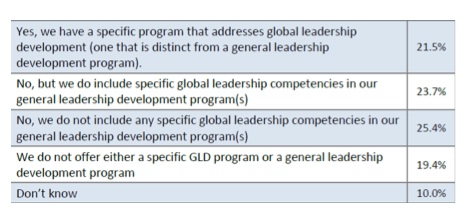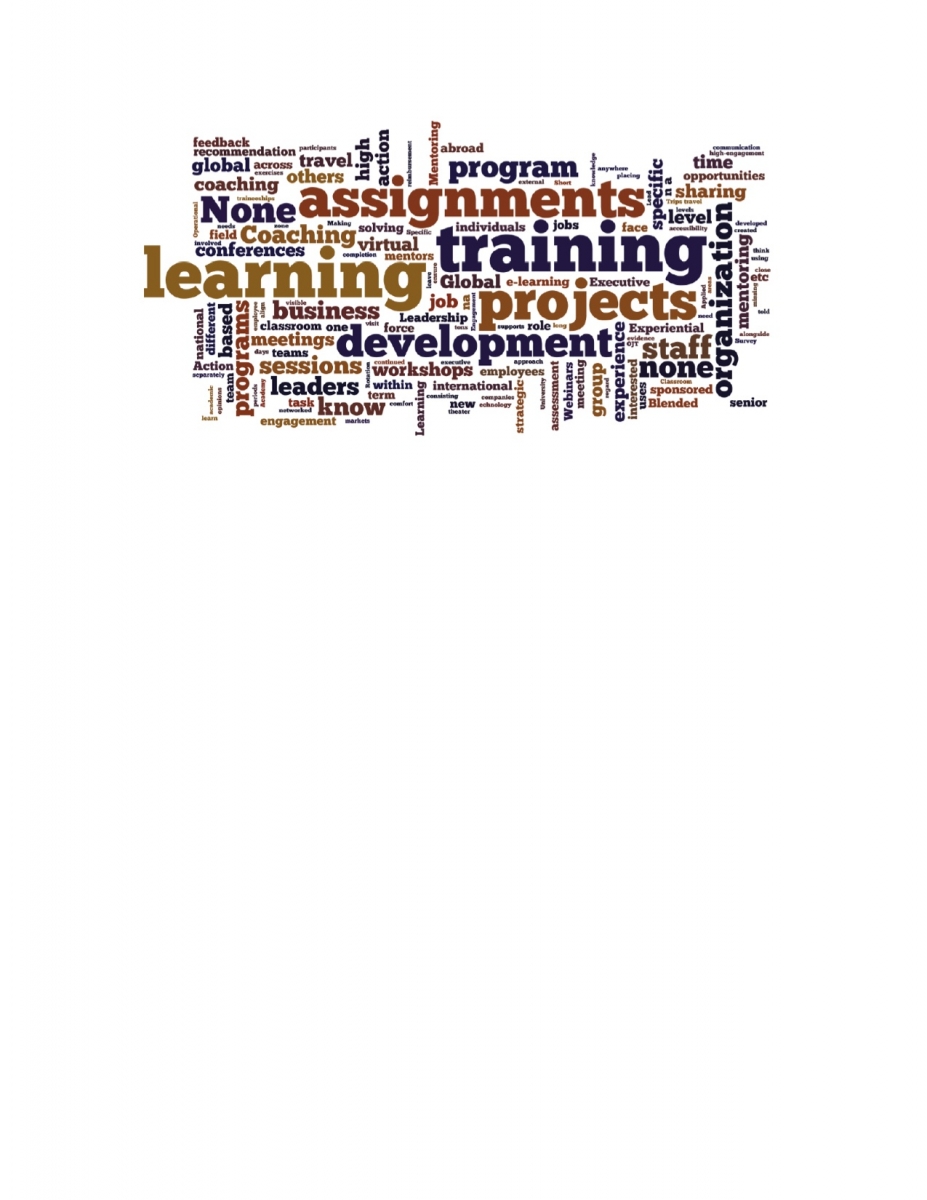
NOTE: Please download the charts at the end of the article; a full PDF of the entire article also can be downloaded there.
While leadership development always has been at the core of the charter for Training professionals, the importance of developing global leadership competencies recently has been raised to new levels of criticality. Existing and upcoming leaders today need to have a broader skill set, one that equips them to think and act globally.
Leadership success depends upon the ability to lead across cultures, time zones, and geographies. It often requires making decisions in ambiguous environments, understanding cultural nuances, and adapting one’s style accordingly. A good track record in one country does not guarantee success in the global arena, nor will merely exposing high-performing leaders to new cultures make them effective multinational leaders. Neglecting global leadership development is every bit as devastating to the organization as missing financial targets.
Drawing from the sixth annual study on global leadership development conducted by American Management Association (AMA), Institute for Productivity (i4cp), and Training magazine, the latest report, titled Developing Global-Minded Leaders to Drive High Performance, indicates that 47.7 percent of the nearly 1,400 organizations surveyed consider developing global capabilities in their leaders a high or very high priority. Employers worldwide are recognizing the criticality of developing global capabilities in leaders.
In fact, 23.7 percent of organizations include specific global leadership competencies in development programs, and a further 21.5 percent have specific programs to address global leadership development that are distinct from general leadership development efforts. It appears effort is trending in the right direction, because in 2010, only 19 percent of organizations had dedicated, distinct global leadership programs.
“Does your organization provide a specific program to develop global leadership capabilities?

At one time, global issues were relevant only for expatriates who would serve a tour overseas. Today, globalization actually shapes the programs for organizations in every sector.
Curricula Successfully Align with Needed Competencies
Organizations are making good progress in developing the competencies required for effective global leadership. The top three competencies deemed important to possess were also the top three competencies most frequently included in global leadership curricula. These are: driving business results; focusing on customers; and communicating clearly. (See Chart 11-12 in downloadable file below.)
One key to developing an effective global curriculum is connecting it to the business. This is clearly the case today as respondents cited that most global leadership development curricula center on driving business results and maintaining a customer focus. Certainly, these are competencies all good leaders need in order to succeed in business, regardless of whether their scope is strictly global.
Leaders need to understand how the business differs in various markets, such as the varying approaches to sales from region to region. For example, an assertive approach may be appropriate in one region, but perceived as disrespectful in another. Localized resources can help identify such issues, considerations, and corresponding development needs. Interviews with successful global executives also can help identify certain competencies and sensitivities that need to be addressed.
Surprisingly, “Addressing performance issues of remote teams” ranked lowest in terms of perceived importance and also for inclusion in development. In the 2013 iteration of this study, one of the key missing ingredients in global leadership development programs was comfort and competency with the latest advances in virtual technology. With employees, customers, and suppliers located worldwide, global leaders must be able to leverage technology for collaboration. While comfort with technology may have improved dramatically, driving business results, communicating clearly, and building trust with remote teams still ranked very high. Discussing performance issues is a sensitive matter, made all the more challenging when the discussion must be held across borders.
Additionally, in the 2014 findings, the leadership behavior change most often attributed to having participated in global leadership development was more collaborative behavior. Collaboration is highly favored as organizations become more matrixed.
First-Hand Experiences Are Most Effective
Hands-on learning opportunities were reported to be the most effective for developing the capabilities required of global leaders. At the top of the list was participating in cross-functional teams, followed by being allocated organized teamwork on a specific customer issue or project and stretch assignments (such as leading a major project or being part of a global project team). Least effective for development were participating in employee affinity groups (such as race, nationality, culture, or religion), coaching by external professionals, and global rotational assignments. (See Chart 9 in downloadable file below.)
Consistent with findings from AMA’s past global leadership surveys, the 2015 study identified that skills in collaboration, communication, and an understanding of how to embrace and work with diversity are the most important requirements for leaders to be successful when operating on a global scale.
In addition to these behaviors, AMA recommends development of three core competencies to improve global leadership effectiveness:
- Knowledge of cultures/customs in specific markets
- Ability to be conversational or fluent in prominent languages within specific markets
- Knowledge about customers and/or prospective customers in specific markets
An example of how such behavior-based evidence might be used to identify a prime candidate for global leadership development is that of a mid-level manager with an interest in developing global savvy. The manager may participate in a behavioral assessment and score high on such traits as embracing diversity and empathy. Performance evaluations may reflect strong skills in managing a virtual team. A coach may report that the manager has demonstrated improvement in cross-functional collaboration. These evidence-based results reflect potential.
When asked “what other delivery approaches does your organization use for developing the capabilities that global leaders need?” respondents cited the following:

While some of the respondents to this study do not have dedicated global leadership programs, it appears that assignments and projects frequently are used for development. These likely would be supported with onsite training and mentoring or coaching by managers. These initiatives are good fallback approaches if there isn’t the time or money to develop a more comprehensive program. But Training professionals would do well to include some training on cultural sensitivity, collaboration, and communication skills.
Limited Resources Present Challenges
Limited time, budget constraints, and inadequate internal resources and training follow-up post-program top the list of obstacles organizations face when developing global leaders. (See Chart 19 in downloadable file below.)
Lack of active participation by senior executives/leaders in the program ranked as an obstacle by 31.7 percent of respondents. The direct involvement of top executives ensures that enterprise-level goals become a driving force in determining the future global skills and competencies needed to deliver results. What’s more, it allows the organization to become more agile in continually improving the global leadership development program in anticipation of long-term strategies.
Lack of consistency in the selection process —ranked in the middle of all the obstacles cited—can be mitigated by the use of assessment instruments. Ideally, Training professionals would invest time in assessing candidates before transitioning to the development phase. Then they would create a dedicated global leadership program so it isn’t necessary to reinvent the wheel every time a leader needs development. Take advantage of existing programs such as Webinars, diversity groups, and affinity groups to help develop diversity activities. Encourage managers to introduce some form of training into daily work by making it part of performance evaluations and by creating stretch projects or internal training opportunities.
When asked “what other obstacles to effectiveness in global leadership development has your organization faced,” respondents cited things such as: HR, not getting performance support; leaders who are not accountable; and lack of time, business resources, transparency, training, connectivity, alignment, and credibility.
Assessments Make Development Investments More Precise
Interestingly, some 25.8 percent of respondents do not use any assessment tools to select participants for global leadership development opportunities. A further 16 percent responded that they didn’t know whether their organization used assessments. Assessments help organizations make targeted development investments, enabling them to select leaders with the greatest aptitude for global competency development, thereby mitigating risk of failure and wasted limited training resources. Well-designed, statistically valid assessments that are properly administered can predict performance and early retention more accurately and fairly than traditional subjective approaches. Assessments can be provided by a third party, include specific tools developed by the organization, or even a combination of both for maximum effectiveness and flexibility.
Perhaps related to the unscientific approach to using assessments, it was surprising to learn that as many as 35.9 percent of respondents did not measure the impact of global leadership development on organizational performance. An additional 17.1 percent of respondents said they did not know if they measured impact. Only 13.4 percent have a formal system for measuring impact, and 33.6 percent measure in an informal way Measuring and reporting on analytical metrics is a relatively new skill that Training leaders need to learn. Consider performance management assessments or 360-degree assessments to measure the progress of employees who participate in training.
Global Competencies Are Best Learned in Person
External academic or leadership development programs, experiential learning (such as games, exercises, simulations, role-play, case studies, etc.), and traditional classroom-based instructor-led training were cited as the most effective approaches for developing global leaders.
To what extent does your organization find the following approaches most effective for development global leaders? (Responses for High/Very High Extent)?

The latest global leadership development study aligns with additional research recently conducted by AMA. This research found that four out of five respondents said that classroomstyle instructor-led training, particularly when supported by pre- and post-program evaluations, was more effective than virtual training when it comes to teaching soft skills such as communication, leadership, and management.
Essential for Future Growth
Developing leaders with global skills and competencies is about enabling the organization to operate more effectively on a global basis. But it is also about creating a more inclusive culture and equipping leaders to be better at collaborating, coaching, and influencing employees with diverse backgrounds, beliefs, and customs. Global leadership isn’t just the “latest trend,” but something essential for an organization’s future growth and success.
About This Study
American Management Association’s sixth annual global leadership development study, titled Developing Global-Minded Leaders to Drive High Performance, was conducted in partnership with i4cp and Training magazine. It includes responses from 1,398 Training professionals, HR managers, and line leaders spanning 96 countries and 37-plus industries. Fifty-three percent of the respondents were from the U.S., and 8.4 percent were from Canada. Respondents came from government (11.6 percent), nonprofit (12.4 percent), private (39 percent), and public (37.1 percent) organizations. Thirty-seven percent of respondents came from organizations employing 10,000 or more employees, and 25.7 percent reported revenues in excess of $10 billion. The study was completed in April 2015. Complimentary copies of the white paper can be downloaded at http://www.amanet.org/training/articles/Developing-Global-minded-Leaders-to-Drive-High-Performance.aspx.
Sam Davis is vice president at American Management Association. He can be reached at sdavis@amanet.org or by visiting www.amanet.org.

